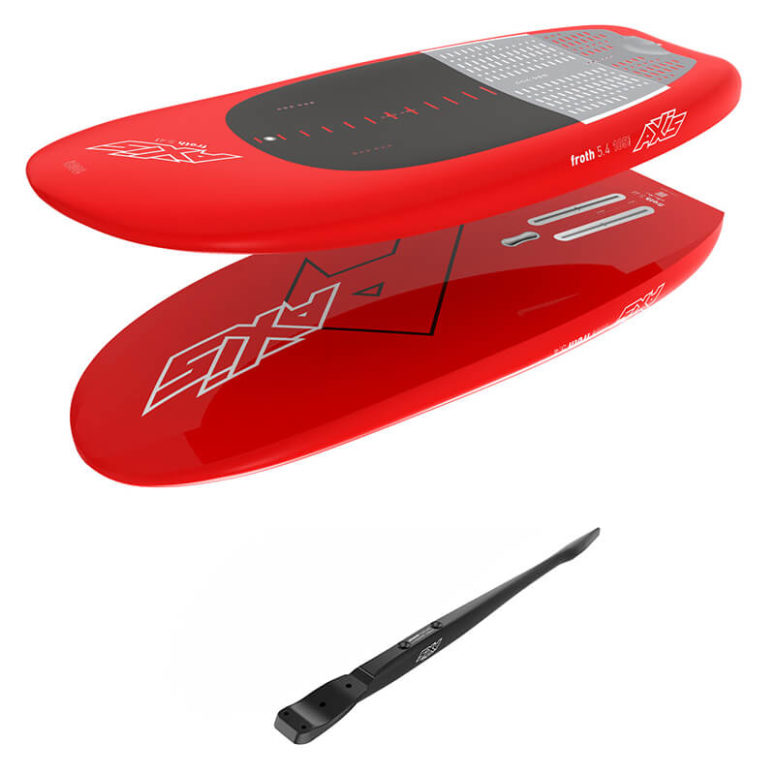

When you purchase gear through links on our site, we may earn a small commission. Here’s why you can trust our tests and our affiliate partner.

AXIS released the Froth V1 last year as their first wing and SUP foil crossover board in the larger sizes. Its squarer outline and high levels of stability per liter made it a popular choice amongst novice to intermediate wingfoilers. This year heralds not only a complete redesign to make it a little leaner and faster, but also a massive range of sizes, ranging from 45l to 160l, enabling you to tailor to pretty much any level of rider or situation. We were given the 105l to test, a comfortable 15l of positive buoyancy, which would suit beginners through to intermediates in lighter winds.
Shape-wise, there’s a clear evolution from the last Froth, bringing it in line with the more progressive shapes. A more pronounced rounded-off nose with a medium amount of rocker in its front section makes the board penetrate the chop far more effectively than the V1, and it gains speed rapidly, whilst remaining very stable. Volume placement contributes towards this stability and is very even throughout the board, with plenty hidden in the nose, and it packs some literage into a compact length. This helps tailor it for the latest swathe of high-aspect, skinnier profiled hydrofoils which need more board speed and persuasion to take off. The flat tail shape both elongates the planing surface and promotes a fuss-free and clean takeoff. The rail bevel on the underside fades out to a straight 90-degree bevel, again increasing the all-important planing surface. The foil box position accommodates the AXIS system perfectly. To line up with the footstrap placements, we found the HPS series wings sat well in the middle of the box, whereas the ART series would sit three quarters of the way forward. The footstrap configuration is a Y setup of self-tapping inserts with plenty of options to get yourself comfortable position-wise.
Construction-wise, it’s a carbon layup over EPS, and retains a light and lively feel to the board, even at 105l. A Gore-Tex vent plug lets the board breathe in the heat or on the plane, and the red gloss finish seems fairly hard-wearing. A luxurious deck pad has defined colored lines across it to let you glance down and gauge your foot position. A clever hump in the kick area allows water to drain out of the slightly concave deck, which lets you feel secure and planted if strapless, striking a good balance between grip and comfort.
The Froth V2 is an exceptionally friendly board to ride in this size, giving adequate buoyancy by maintaining a generous level of volume in a short board, and therefore minimizing swing weight, making it feel sportive for its literage and more controllable in the higher wind ranges, where it seems to point upwind more aggressively than a flat-nosed board.
AXIS responded to prone consumer demand to enable extra turning mobility in their system by a small change to their existing B-Series fuse, which essentially brings the front wing 40mm closer to the mast. The B-Series fuse is compatible with their HPS and ART ranges, as well as some of the smaller BSC and PNG front wings.
In the water, the pitch control feels a little different at first, and you may wish to shift your foil box position a little further forward to help balance your board out.
Turning-wise, it feels almost as if you’ve dropped a front wing size but not sacrificed any stability. The foil has a new eagerness to turn, particularly in the yaw axis, and it provides a more connected and ‘surfy’ feeling which opens up tighter radiuses and more aggressive turning, where it provided a more constant front foot pressure and feedback throughout a committed turn. To get the most out of it, we think it pairs best with the smaller P-Series progressive tails.
Pumping-wise, we found that the Ultrashort Advance fuse let you get ‘out of the hole’ a little easier if you do lose speed and feel like you’re going to bog; getting back up to pace didn’t seem too stressful. There’s also perhaps a slightly slower cadence required to maintain speed.
Carrying the new fuse over into the ever-popular method of wing propulsion, the extra mobility on the wave is definitely apparent, and it felt a little more sure-footed at speed. You maybe sacrifice a tiny fragment of upwind ability, but on the smaller, faster foils the B-Series generally accommodates, it’s pretty negligible.
It’s truly amazing what significance a 40mm geometry change can do to a system, and kudos to AXIS for listening to consumer demand and opening the door to a bucket more performance in their already comprehensive foil ecosystem. You could compare it to ordering that ‘handling pack’ on your new BMW. RB
